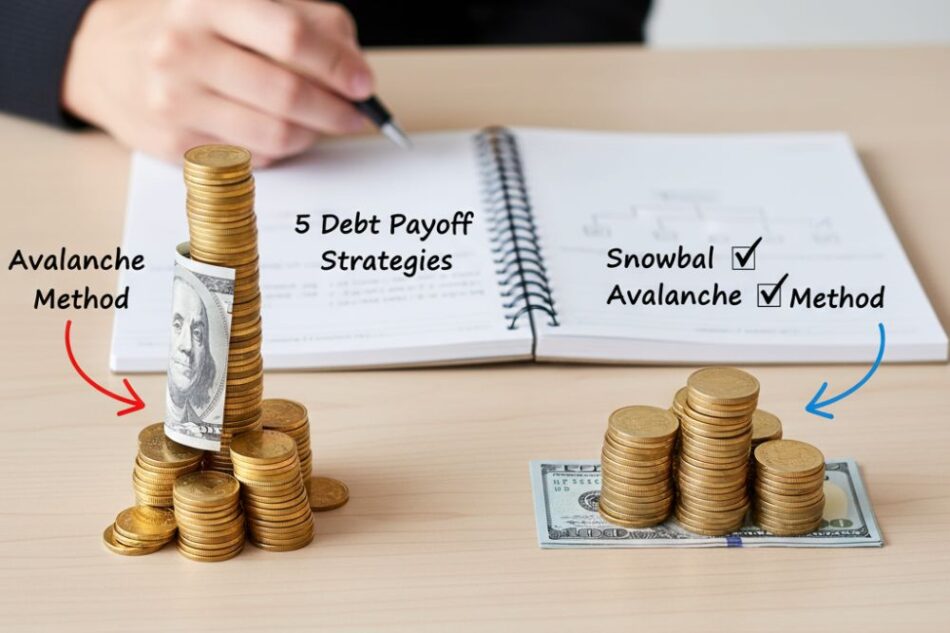Struggling with multiple debts? Learn about the most effective debt payoff strategies including the Snowball vs. Avalanche method and other proven approaches to regain financial control. This in-depth guide from The Scribble World breaks down each strategy, helping you choose the best one for your goals, budget, and mindset. Understand how prioritizing payments, managing interest rates, and staying consistent can make your debt-free journey faster and less stressful. Whether you’re clearing credit cards, student loans, or personal debt, these practical steps will help you take charge of your finances in 2025 and beyond.
5 Debt Payoff Strategies Explained (Snowball vs. Avalanche & More)
Getting out of debt can feel overwhelming, especially when multiple payments, interest rates, and due dates pile up. But with the right plan, financial freedom is absolutely achievable. There isn’t a one-size-fits-all solution your best approach depends on your motivation, financial habits, and goals. In this article, we’ll explore 5 debt payoff strategies explained, focusing on the popular Snowball vs. Avalanche methods, along with other effective approaches to help you take control of your finances once and for all.
1. The Snowball Method Small Wins Build Momentum
The Debt Snowball Method focuses on building emotional motivation. You start by paying off your smallest debts first, while continuing to make minimum payments on larger ones.
Once the smallest balance is cleared, that payment amount “snowballs” into the next debt. Over time, your payments grow larger, and your debts shrink faster creating a strong sense of progress and accomplishment.
Why it works:
-
Builds positive momentum and motivation.
-
Encourages consistent payments.
-
Helps maintain emotional satisfaction as debts disappear one by one.
This strategy is perfect for people who need quick wins to stay encouraged throughout the debt payoff journey.
2. The Avalanche Method Save More on Interest
The Debt Avalanche Method takes a more mathematical approach. You focus on paying off the debt with the highest interest rate first, regardless of balance size.
For example, if your credit card has 25% interest while a student loan sits at 8%, your first target should be the credit card. You continue paying minimums on other debts while directing any extra money toward the high-interest balance.
Why it works:
-
Saves you the most money in interest payments.
-
Helps you become debt-free faster (if you stay disciplined).
-
Perfect for people who prefer logic and efficiency over emotion.
In the debate of Snowball vs. Avalanche, the Avalanche method often wins mathematically but motivation plays a key role in long-term consistency.
3. The Debt Consolidation Approach Simplify Payments
If you’re managing several debts with different interest rates and due dates, debt consolidation can make your life easier. This strategy involves combining multiple debts into one single loan or credit account, ideally at a lower interest rate.
Benefits of consolidation:
-
Simplifies your monthly payments.
-
Reduces the average interest rate.
-
Helps improve credit utilization if managed well.
However, this method requires discipline if you keep using your old credit cards or take on new loans, you might end up with even more debt.
4. The Balance Transfer Strategy Short-Term Relief
Some credit cards offer balance transfer options with 0% or low-interest introductory periods. This means you can move high-interest credit card debt onto a new card and pay little or no interest for 6–18 months.
When to consider this method:
-
You have good credit.
-
You can realistically pay off the balance during the promotional period.
-
You understand and plan for transfer fees or interest hikes afterward.
This can be a temporary but powerful tool for those struggling with high-interest debts — especially when combined with a structured payoff plan like Snowball or Avalanche.
5. The Hybrid Method The Best of Both Worlds
Can’t decide between Snowball vs. Avalanche? You don’t have to. A Hybrid Strategy combines emotional motivation with financial optimization.
Start by using the Snowball method to clear a few small debts quickly. Once you feel more confident and have freed up some cash, switch to the Avalanche method to attack high-interest balances.
This balanced approach helps maintain motivation while still minimizing total interest paid giving you the best of both worlds.
Which Strategy is Right for You?
Choosing between the Snowball vs. Avalanche or other debt payoff methods depends on your personality and financial situation:
-
Choose Snowball if you need early motivation and psychological wins.
-
Choose Avalanche if you’re focused on saving money long-term.
-
Choose Consolidation if juggling multiple payments feels too complex.
-
Choose Balance Transfer if you qualify for low-interest offers and can commit to short-term repayment.
The most important thing is consistency. No strategy works without discipline, budgeting, and avoiding new debt.
Final Thoughts
Understanding the 5 debt payoff strategies explained above gives you the power to take control of your money and reduce financial stress. Whether you lean toward the Snowball for motivation or the Avalanche for logic, both paths lead to the same destination freedom from debt.
Start small, stay consistent, and celebrate every milestone along the way. The road to financial independence might take time, but every payment brings you one step closer.









